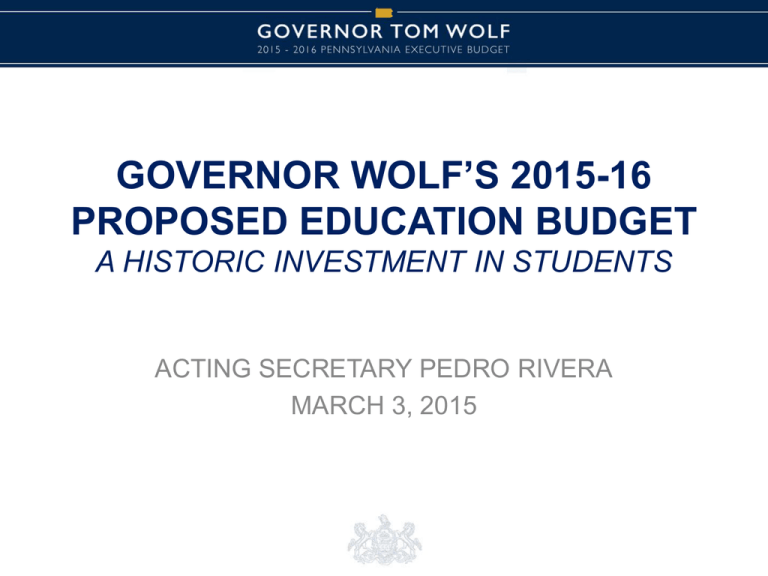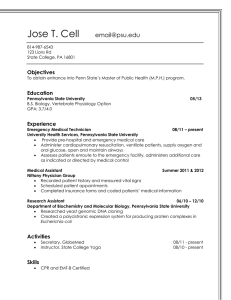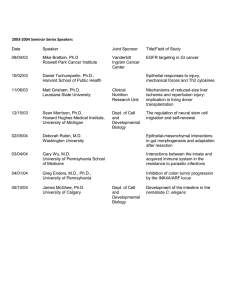GOVERNOR WOLF’S 2015-16 PROPOSED EDUCATION BUDGET A HISTORIC INVESTMENT IN STUDENTS
advertisement

GOVERNOR WOLF’S 2015-16 PROPOSED EDUCATION BUDGET A HISTORIC INVESTMENT IN STUDENTS ACTING SECRETARY PEDRO RIVERA MARCH 3, 2015 PENNSYLVANIA’S FUTURE DEPENDS ON 3 THINGS: Jobs that Pay Schools that Teach Government that Works The Commonwealth’s education system is central to Pennsylvania’s agenda to build a better future. HISTORIC INVESTMENT IN EDUCATION • Over the last four years, schools across Pennsylvania have suffered $1 billion in cuts that led to massive layoffs, huge property tax increases, and the elimination of valuable programs. • Gov. Wolf has proposed the Education Reinvestment Act that will restore funding for schools and make natural gas companies pay their fair share. • Gov. Wolf’s budget will increase the state’s share of funding for public education to 50 percent and cut school district property taxes by more than 50 percent for the average homeowner. WE HAVE SEEN WHAT HAPPENS WHEN THE STATE FAILS TO INVEST IN OUR CHILDREN AND SCHOOLS… EDUCATION CLASSROOM FUNDING $7,000,000,000 $6,500,000,000 $6,000,000,000 $5,500,000,000 $5,000,000,000 $4,500,000,000 $4,000,000,000 $3,500,000,000 $3,000,000,000 2005-06 2006-07 2007-08 2008-09 2009-10 2010-11 2011-12 2012-13 2013-14 2014-15 PERCENTAGE OF STUDENTS ADVANCED OR PROFICIENT IN READING 74% 74% 72% 72% 71% 72% 70% 70% 70% 70% 68% 68% 67% 66% 64% 62% 2005-06 2006-07 2007-08 2008-09 2009-10 2010-11 2011-12 2012-13 2013-14 PERCENTAGE OF STUDENTS ADVANCED OR PROFICIENT IN MATH 78% 76% 77% 76% 76% 73% 74% 73% 72% 72% 72% 69% 70% 68% 68% 66% 64% 62% 2005-06 2006-07 2007-08 2008-09 2009-10 2010-11 2011-12 2012-13 2013-14 Education Classroom Funding $7,000,000,000 $6,500,000,000 $6,000,000,000 $5,500,000,000 $5,000,000,000 $4,500,000,000 $4,000,000,000 $3,500,000,000 $3,000,000,000 2005-06 2006-07 2007-08 2008-09 2009-10 2010-11 2011-12 2012-13 2013-14 Advanced/Proficient Reading 74% 74% 71% 72% 70% 70% 68% 66% 64% 62% Advanced/Proficient Math 67% 68% 72% 72% 70% 70% 78% 76% 74% 72% 70% 68% 66% 64% 62% 76% 73% 72% 69% 68% 77% 76% 73% 72% THE 2015-16 BUDGET: $1 BILLION RESTORATION FOR EDUCATION • • • • • • • • • $400 million increase in Basic Education Funding $100 million increase in Special Education Funding $120 million increase in Early Childhood Education $160 million in savings from Cyber Charter Reform $143 million increase in Higher Education Investment $20 million Career and Technical Education and Equipment Grants $8 million for Career Counselors in middle and high schools $9 million for Dual Enrollment $47 million for other preK-12 and higher education investments THE STATE WILL PAY ITS FAIR SHARE • The 2015-16 Budget is the first phase of a 4-year goal to increase overall preK-12 investment by $2 billion in order to meet the state’s educational commitments and provide all children with a quality public education. • The Executive Budget also includes a historic $3.8 billion property tax relief package – which will finally bring the state’s share of public education up to 50 percent for the first time since the early 1970’s. BASIC EDUCATION FUNDING $6.13 BILLION • $400 million increase for Basic Education Funding – representing the largest increase in Pennsylvania history Full restoration of funding for the Accountability Block Grant and Educational Assistance Program tutoring Reimbursement of approximately 10% of mandatory tuition payments to charter schools Additional restoration of Basic Education Subsidy cuts instituted since the 2010-11 school year BASIC EDUCATION FUNDING • Pennsylvania needs a real school funding formula. • We will work with the bipartisan Basic Education Funding Commission to reach an agreement on a formula by June 10 and enact it into law by June 30, so that it will take effect in 2016-17. • Our goals for a new funding formula: Adequacy Equity Predictability Accountability SPECIAL EDUCATION FUNDING $1.15 BILLION • Continue to implement the formula developed by the bipartisan Special Education Funding Commission • Increases the student based formula amount to $115.8 million STRONGER ACCOUNTABILITY • It is time for a renewed focus on strong and fair accountability at all levels – for students, educators and schools. • The state must start by listening to key stakeholders and developing an accountability framework that will improve and support the success of our public education system, reduce over-testing and ensure public confidence in the performance of our schools. • We must enact new accountability measures, working with the Legislature, as part of the state’s new school funding formula. WE WILL INVEST MORE AND WE WILL EXPECT MORE • Total school district spending exceeds $3 billion per year on administrative, back-office, transportation and other central office costs. • We need to refocus our resources where they belong: in the classroom. • School districts should work together and with the Intermediate Units to achieve $150 million in savings through shared services and other efficiencies. CYBER CHARTER FUNDING REFORM • School districts spent $421 million on mandatory payments to cyber charter schools in 2013-14. • Cyber charter schools are fundamentally different than brick-and-mortar charter schools in their cost structure and this needs to be recognized. • Cyber charter schools are more comparable to Intermediate Unit online learning programs. CYBER CHARTER FUNDING REFORM • New funding formula based on the highest-cost of several best-performing, comparable Intermediate Unit online education programs • Regular education = $5,950 per cyber charter student • Special education = based on recommendations from the Special Education Funding Commission • Based on 2013-14 data, school districts would save at least $160 million ADDITIONAL CHARTER SCHOOL REFORMS • Making the pension “double dip” prohibition permanent and • Requiring reimbursement based on audited costs LIBRARIES $60.8 MILLION • $1.96 million State Library • $53.5 million Public Library Subsidy • $2.8 million Library Access • $2.6 million Library Services for the Visually Impaired and Disabled PRE-KINDERGARTEN PROGRAMS WORK Low-Income Kids Who Had Pre-K Outperform Peers by 3rd Grade % Proficient/Advanced (Grade 3 PSSA) 70% 65% 65% 60% 60% 58% 54% 55% 50% Math Reading No Pre-K Counts Pre-K Counts HIGH-QUALITY EARLY CHILDHOOD EDUCATION $494 MILLION • $120 million investment to increase slots by at least 75 percent $100 million increase in Pre-K Counts $20 million increase in Head Start Supplemental Assistance Program • Part of a multi-year commitment to reach universal pre-k for 3- and 4-year-olds • $238 million Early Intervention PA RISING: HIGHER EDUCATION AND WORKFORCE DEVELOPMENT FOR PA’S FUTURE As Education Increases, Unemployment Drops... ...and Income Rises $60,000 2014 Unemployment Rate 8.5% 8% 6% 5.6% 4.3% 4% 2.7% 2% 2013 PA Median Personal Income 10% $50,058 $50,000 $40,000 $35,000 $30,000 $21,859 $20,000 $14,136 $10,000 0% $Less than High High School, No School College Associate's Degree Bachelor's and Higher Less than High High School, School No College Associate's Bachelor's and Degree Higher SETTING A GOAL FOR PENNSYLVANIA’S FUTURE • Today, just 48 percent of Pennsylvanians have a college degree or industry-recognized certification. • By 2025, fully 60 percent of good-paying, reliable Pennsylvania jobs will require these credentials. • Pennsylvania will close that gap – making a college degree or high-value industry-recognized certification available to at least 650,000 additional commonwealth residents over the next decade. BUILDING A BRIDGE FROM HIGH SCHOOL TO COLLEGE AND CAREERS • $15 million as the first step to transform and modernize Career and Technical Education by establishing and enhancing programs statewide that prepare students for success in today’s high-skill economy • $5 million for Career and Technical Education Equipment Grants • $8 million for career counselors in middle and high schools • $9 million to re-establish the successful Dual Enrollment Program REINVESTING IN COLLEGE SUCCESS • The 2015-16 Budget invests in our students and economy by restoring the higher education cuts over the next two years. • We must work together to improve higher education success in partnership with the community colleges and the Pennsylvania State System of Higher Education (PASSHE), focusing on: Performance Affordability Student completion Transformation through structured career pathways and partnerships with employers REINVESTING IN COLLEGE SUCCESS $140.9 MILLION IN RESTORATIONS • $15 million increase for community colleges • $45 million increase for the Pennsylvania State System of Higher Education (PASSHE) • $80.9 million increase for State-Related Universities $49.6 million increase for the Pennsylvania State University $14.9 million increase for the University of Pittsburgh $15.4 million increase for Temple University $921,000 increase for Lincoln University CREATING WORKFORCE PARTNERSHIPS FOR ECONOMIC SUCCESS • Education and workforce needs must be aligned for students to succeed • $1.2 million increase for Pennsylvania College of Technology • $863,000 increase for Thaddeus Stevens College of Technology • $4.6 million increase for Adult Literacy integrated into job training/workforce development For additional information on the Education Budget, visit www.education.state.pa.us Estimated funding by school district is available at www.SchoolsThatTeach.com For more information about Governor Wolf’s 2015-16 Budget, visit www.budget.state.pa.us

